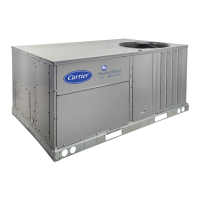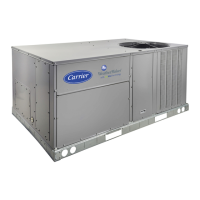ITEM
SW.LG
FTS.L
IGC.L
RMI.L
ECS.L
SFS.L
DL1.L
DL2.L
IAQ.L
FSD.L
PRS. L
EVC.L
PRG.L
Table 89 -- Switch Logic Configuration
EXPANSION
SWITCH LOGIC: NO / NC
Filter Status Inpt-Clean
IGC Feedback - Off
RemSw Off-Unoc-Strt-NoOv
Economizer Switch - No
Fan Status Sw, - Off
Dmd,Lmt,Sw,1 - Off
Dmd,Lmt,2 Dehumid - Off
IAQ Disc, Input - Low
Fire Shutdown - Off
Pressurization Sw, - Off
Evacuation Sw, - Off
Smoke Purge Sw, - Off
[ RANGE 1 CCNPOINT [ DEFAU_
Open/Close
Open/Close
Open/Close
Open/Close
Open/Close
Open/Close
Open/Close
Open/Close
Open/Close
Open/Close
Open/Close
Open/Close
FLTSLOGC
GASFANLG
RMTINLOG
ECOSWLOG
SFSLOGIC
DMD SWl L
DMD SW2L
IAQINLOG
FSDLOGIC
PRESLOGC
EVACLOGC
PURGLOGC
Open
Open
Open
Open
Open
Open
Open
Open
Open
Open
Open
Open
Table 90 -- Display Configuration
ITEM EXPANSION RANGE UNITS POINT DEFAULT
TEST Test Display LEDs ON/OFF TEST Off
METR Metric Display ON/OFF DISPUNIT Off
LANG LanguageSelection O-l(multi-text strings) LANGUAGE 0
PAS.E Password Enable ENABLE/DISABLE PASS EBL Enable
PASS Service Password 0000-9999 PASS_/ORD 1111
Table 91 -- Remote Switch Configuration
CCN
ITEM EXPANSION RANGE POINT
REMT Remote Input State ON/OFF RMTIN
RM.CF Remote Switch Config 0 - 3 RMTINCFG
RMI.L RemSw Open/Close RMTINLOG
Off-Unoc-Strt-NoOv
Remote Switch Logic Configuration ((bqfiguration--€
SW..LG--cRMI.L) -- The control allows for the configuration
of a normally open!closed status of the remote input switch via
RMLL. If this variable is configured OPEN, then when the
switch is open, the remote input switch perceives the logic state
as OFF. Correspondingly, ifRMLL is set to CLOSED, the re-
mote input switch will perceive a closed switch as meaning
OFF. See Table 92.
Hot Gas Bypass E Hot gas bypass is an active part of
the A-Series (_nfortLink TM capacity staging and minimum
evaporator load protection functions. It is controlled though the
Minhnum Load Valve function.
The hot gas bypass option consists of a solenoid valve with
a fixed orifice sized to provide a nominal 3-ton evaporator load
bypass. A hot gas refrigerant line routes the bypassed hot gas
from Circuit A's discharge line to Circuit A's evaporator
distributor. When the unit control calls for hot gas bypass, the
hot gas enters the evaporator coil and adds refrigeration load
to the compressor circuit to reduce the cooling effect from
Circuit A.
The hot gas bypass system is a factory-installed option
installed on Circuit A only. This function is enabled at Config-
urafion_COOL---_MLV. When this function is enabled, an
additional stage of cooling capacity is provided by the unit
control staging sequences (see Tables 52, 54, 58, and 60).
Space Temperature Offset E Space temperature off-
set corresponds to a slider on a T56 sensor that allows the occu-
pant to adjust the space temperature by a configured range
during an occupied period. This sensor is only applicable to
units that are configured as either 2-Stage SPT or Multi-Stage
SPT control ((bnfigurafion -+UNIT-€C TYP = 5 or 6).
ITEM
SP.O.S
SP.O.R
SPTO
EXPANSION RANGE UNITS CCN
POINT
Space Temp Enable/ SPTOSENS
Offset Sensor Disable
Space Temp 1 - 10 SPTO_RNG
Offset Range
Space Temperature +- SRO.R ^F SPTO
Offset
Space Temperature Offset Sensor ((bnfiguration--cUNIT
--¢SENS--cSRO.S) -- This configuration disables the reading
of the offset slider.
Space Temperature Offset Range ((bnfiguration-
--+UNIT--+SENS--+SRO.R). -- This configuration establishes
the range, in degrees E that the T56 slider can affect SPTO
when adjusting the slider from the far left (-SRO.R) to the far
right (+SRO.R). The default is 5° E
Space Temperature Offset Value (Temperatures-+AIR.T
--+SPTO) -- The Space Temperature Offset Value is the read-
ing of the slider potentiometer in the T56 that is resolved to
delta degrees based on SRO.R.
TIME CLOCK CONFIGURATION
This section describes each Time Clock menu item. Not
every point will need to be configured for every unit. Refer to
the Controls Quick Start section for more information on what
set points need to be configured for different applications. The
Time Clock menu items are discussed in the same order that
they are displayed in the Time Clock table. The Time Clock
table is shown in Table 93.
Hour and Minute (HH.MM)_ The hour and minute
of the time clock are displayed in 24-hour, military time. Time
can be adjusted manually by the user.
When connected to the CCN, the unit can be configured to
transmit time over the network or receive time from a network
device. All devices on the CCN should use the same time. Only
one device on the CCN should broadcast time or problems will
occur.
Month of Year (MNTH) _ This variable is the current
month of the calendar year.
Day of Month (DOll4)_ This variable is the current
day (1 to 31) of the month.
Day of Week (DAY) _ This variable is the current day
of the week (Monday = 1 through Sunday = 7).
Year (YEAR) _ This variable is the current year (for ex-
ample, 2005).
Local Time Schedule (SCH.L) _ This submenu is
used to program the time schedules. There are 8 periods
(PER.1 through PER.8). Each time period can be used to set
up a local schedule for the unit.
75

